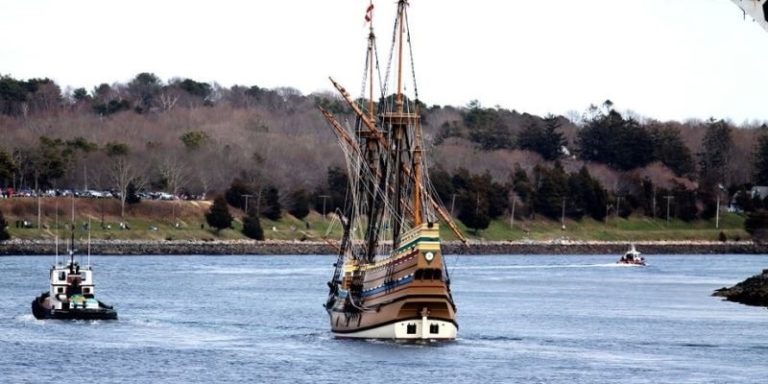A New Mayflower Voyage, Captained by AI Technology
After several setbacks, the Mayflower Autonomous finally crossed the Atlantic.
By: Sarah Cowgill | June 21, 2022 | 490 Words

Replica of the original Mayflower (Photo by Jonathan Wiggs/The Boston Globe via Getty Images)
It was September 16, 1620, when the Mayflower set sail from England. Destination: the new world. The new colonies, to be exact, to escape religious persecution under the reign of King James I. The Mayflower was 106 feet long and 25 feet wide, and it carried 102 passengers and 30 crew members to Plymouth, Massachusetts, in 66 days.
Fast forward 402 years later, and another voyage has made history. The Mayflower Autonomous, a boat navigating only by Artificial Intelligence (AI), made nearly the same trek and became the first unmanned craft to complete the Atlantic crossing. That means the ship traveled with no humans onboard – it was totally controlled by computer. The trip took 40 days. Due to tech problems that had to be fixed, the trip involved one unplanned layover.

The experiment was planned to collect data on AI technology and navigation. Excited researchers and scientists say the new Mayflower did just what she was designed to do. “The journey she made across was arduous,” said project director Brett Phaneuf, who is also a founder of ProMare, the maritime research group that led the expedition.

The Mayflower Autonomous Ship sails in Plymouth harbour following its launch. It can be seen on the right, with support vessels nearby. (Photo by Finnbarr Webster/Getty Images)
The Pilgrimage
The idea to recreate the Mayflower crossing began in 2015 when plans were underway to make the unmanned journey across the rough Atlantic Sea and land in Plymouth, MA, on the 400th anniversary of that historic voyage that Americans celebrate today. The idea attracted global partners, including technology companies Nvidia and IBM. The 49.2-foot vessel was equipped with an AI captain, six AI-powered cameras, 15 computer systems, more than 30 sensors, navigation tech, and a weather station.
A late 2020 launch was scheduled. But setbacks here and there pushed the date to 2021, and after a few days into the voyage, the vessel returned due to a problem that only a human could fix. But another launch was scheduled, and the Mayflower Autonomous launched again into deep waters on April 27, 2022. Except there was a change in destination: it was heading not to Massachusetts, but to Virginia.
The Landing
After a two-week layover in the Azores islands (located in the middle of the Atlantic Ocean) to fix the generator and wait for better weather, the voyage resumed. But not for long: another power problem arose, and the Mayflower Autonomous was diverted to Halifax, Nova Scotia, in Canada. The vessel finally landed in Canada on June 5, 2022. Even though it didn’t make it to Plymouth, unlike the original Mayflower, the boat was the first to cross the Atlantic with no humans onboard.
ProMare updated the status on social media: “Our journey … has been eventful and challenging. So we are thrilled that our ship completed the endurance challenge of being the first self-directed autonomous ship to cross the Atlantic Ocean.”
















